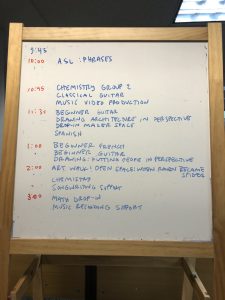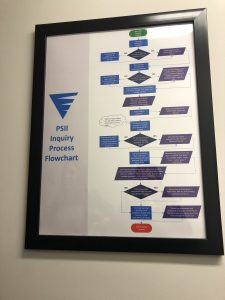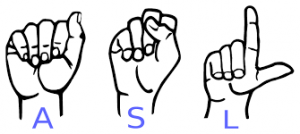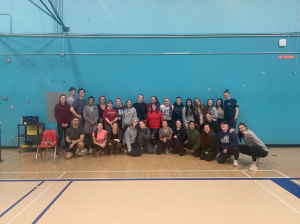Welcome back to another interesting blog! This past week, our cohort had the opportunity to visit PSII, the “Pacific Institute of Innovation and Inquiry”, an independent high school located in downtown Victoria. This school differs from traditional schools as students take an inquiry-based approach to learning and their school schedules are altered to the needs and focus of the students. At first, I was skeptical to see how this type of classroom would benefit students, but after seeing it in person, there are many aspects that I could see myself potentially incorporating in my own classroom in the future.

Here is a photo of a daily session schedule at PSII.
Some of the positive aspects that I thought this school offered included flexible time tables and collaborative work environments. At PSII, they do not enforce strict deadlines for their students, which allows students more time to focus on things they may struggle with, and spend less time on the things they have already mastered. A big problem with our current education system is that we need to have students achieve certain things by a certain time. However, as educators, if we truly believe that learning is a curve and everyone learns at different speeds, we should try to allow more flexibility for our students. Furthermore, I thought the collaborative workspaces were a great addition to the school. The way the desks were arranged allowed students to work with people from other grades. In a high school environment, this is an extremely rare set up as often times students only see those who are in the same grade.
While I see the value of this type of school, I feel that it would not be suitable for all types of learners. Firstly, in an elementary school setting, students often do not yet have the self-regulation skills that would be necessary to complete an inquiry-based project. While the new curriculum stress autonomy in the classroom, young students still need guidance when it comes to school. At PSII, students are free to attend sessions at their own leisure which would not be appropriate in an elementary setting for the meer purpose of safety. Secondly, it would be extremely difficult for teachers to make individualized learning plans for all of their students and check in on a day-to-day basis. The faculty at PSII meet with a group of students each morning to discuss the plan for the day. Unfortunately, in the public education system, there is not enough time, resources, or money to set up this form of schooling for every single student.

Here is the flow chart that PSII teachers use to help guide students through the inquiry process.
Overall, I thought what the PSII school is doing with their students is an excellent idea and allows many of their students to thrive outside of the public education system.
– Ms. G 🙂




